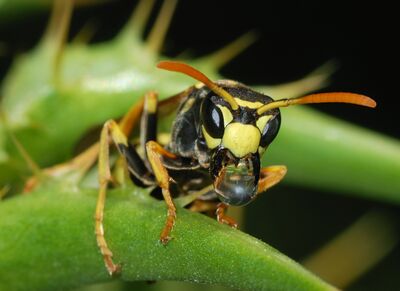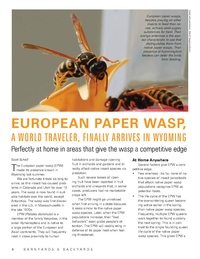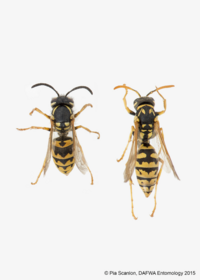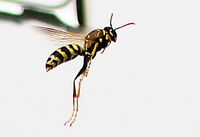European Paper Wasp

The European Paper Wasp

Looking much like a Yellow Jacket, this is a relatively new pest for us here in Wyoming. This creature has been a problem in neighboring states for over 15 years now - only just this past summer being confirmed in Wyoming. Anecdotal reports suggest it's been in Wyoming for at least 5 years. We had confirmed captures here in Casper this year (summer 2016).
The European Paper Wasp (EPW) though quite similar looking to a Yellow Jacket (YJ) - is an all together different creature, and problem. We've some effective control methods for YJs, but they're not effective on EPWs. Baits that are somewhat effective on EPWs often also attract Honey Bees - a situation that could rapidly become disastrous for beekeepers.
The University of Wyoming Ag Extension office's "Barnyards & Backyards" publication for Winter 2016 has some very good information, as well as a bit of hope. Just click the image at the right to view the entire PDF file.
Yellow Jacket vs European Paper Wasp

Though very similar appearing at first glance, closer examination shows these are two different creatures. Definitive difference are the colors of the antennae, color patterning, abdomen shape and thorax to abdomen junction. The Antennae are a quick, sure method of ID - YJs are black, EPWs are Yellow.
In flight, the EPW can be differentiated from a YJ by their tendency to dangle their rear legs. YJs tend to keep their legs up, next to their abdomen in flight.

Why bother?
EPWs are voracious foragers. They've become an economically significant pest for fruit and berry growers, damaging skins to collect juices. There are reports of of EPWs ruining entire crops. They are also carnivorous, preying on other insects for protein to feed their larvae in the nest. As we know, one handy source of prey is our bee yards. Similar to honey bees, once an abundant food source has been found, EPWs will tend to forage until that source has been depleted or is no longer desired. If that source happens to be one of your hives, they may kill your colony. Being somewhat larger and stronger than Yellow Jackets, EPWs do pose more of a threat to our honey bees. EPWs are larger than honey bees, stronger, have a slick hard cuticle that is difficult for defenders to hold on to and as with most all wasps, EPWs do not have a barbed stinger and are able to sting multiple times.
If you do see individual EPWs around your hives, it may be helpful to kill them on sight. This might prevent scouting reports from reaching the main nest. At best, however, this is only a delaying tactic.
Locating Nests
Nests can be located using a technique very similar to 'bee lining'. However, be careful - the aggressiveness of the EPW can make approaching a nest very unpleasant to dangerous. But why locate nests? Well, to destroy them of course! To date, this appears to be one of the more effective acute population control methods.
Control
- locate and destroy nests
- Techniques similar to "bee lining" can be used to locate nests.
- Commercial Wasp sprays (20' foam type) are recommended. However, EPWs seem to be able to 'shrug off' many insecticides. Make sure your escape route is clear.
- limit nesting locations near your hives
- Calk cracks, seal gaps, etc
- traps
- Dependent on a selective attractant
- baits
- Same problem - but can also be infused with insecticide to eradicate nests
In order for traps to be effective, an attractant must be used. Those normally used for Yellow Jackets are NOT attractive to EPWs. Sadly, the few that are effective for EPWs might also attract Honey Bees. This is a dilemma I hope to work on this summer. I encourage anyone and everyone with an interest and time to try - something. See if you can come up with a mix/bait/attractant that will pull in EPWs only. Remember, what they're seeking is going to change over the season. Once a selective and effective bait and timing are found, traps come into play and control baits laced with slow acting, contact toxins - like Fipronil - should be effective on EPWs and their nests.
A trap that works(?)

Several have reported success using a new Visual Baited sticky trap by Rescue. Called "VisiLure", it uses a digital pattern that seems to be attractive to EPWs. This Youtube hosted video (3:45) explains how it works. Most home improvement stores, garden centers and many hardware shops sell these traps. They can be a bit expensive - special as they're disposable. It pays to shop around. To date, Wal-Mart and Amazon have had the better prices.
Colorado Ag info
The EPW has been confirmed in Colorado for some time now. Their information flier can be found to the right.